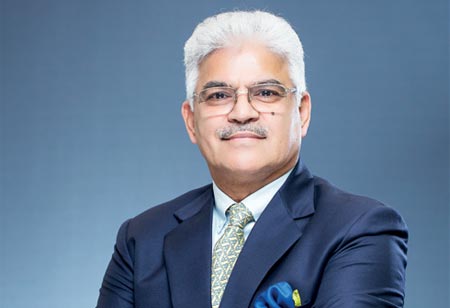By Vineet Kashyap, Managing Director, B.L. Kashyap & Sons

Vineet Kashyap, Managing Director, B.L. Kashyap & Sons
B. L. Kashyap and Sons Ltd. (BLK) is one of the leading Construction, Infrastructure and Civil Engineering companies in India. They have been instrumental in constructing some of the country’s leading buildings & infrastructure, efficiently through cutting-edge technical systems and management integration.
Green building technology has become one of the hottest trends in construction. Green technology makes buildings more energy-efficient and sustainable, so they have a lower carbon footprint and a reduced impact on the environment. With Governments, businesses and civil societies fighting to save the ecology through a slew of stringent and strong policy interventions, green construction is here to stay.
Green technology makes use of industrial waste gypsum, does not need any plastering, uses less cement, sand, steel and water than conventional building materials. It provides reduced built-up areas that help buildings achieve more efficiency compared to conventional buildings. Versatility in construction methods and the speed of construction is relatively faster and lightness of structures bring safety against earthquake forces. Green technology in construction brings in a lot of advantages for the builders, building owners, and tenants who now realize the impact of green technology. Building owners benefit from having lower ongoing costs of operations, improved rates of tenant retention and higher building values and the market benefits of being a ‘green’ business. Some of the leading players have already incorporated green technology in construction voluntarily even before the government announced policies.
Green buildings are designed to reduce the overall impact of the built environment (Siting, design, construction, operation, maintenance, renovation and deconstruction) on human health and the natural environment by efficiently using energy, water, and other resources, protecting occupant health and improving employee productivity and reducing waste, pollution and environmental degradation. The efforts towards sustainable development involve the optimal use of natural resources, reduction and recycling of waste material, water purification, air purification, sewage treatment, environmental remediation, energy conservation and significantly reduce pollutant emissions. Green technology aims at the active use of renewable resources – sunlight, water and wind through solar panels, dams, geothermal wells wind turbines.
“Energy-efficient green building solutions can automatically turn off HVAC systems when not needed in order to maintain an accurate temperature and humidity in the room”
A green building’s efficiency can be amplified by the adoption of innovative methods and technologies. There are many green building methods and technologies being used across the world like; Biomimicry, green roofs, vertical & rain gardens, Glass Fibre Reinforced Gypsum (GFRG) panels, smart glass panes and others.
It is estimated that 30 percent to 40 percent of commercial buildings is typically unoccupied at any given time. Green building technology makes use of motion detectors, RFID scanners, access card readers, and other sensors to monitor the occupancy status of the buildings. Whenever an area of a structure becomes unoccupied, the green technology automatically shuts off lights and adjusts HVAC, cooling, heating, and ventilation options. Building owners can see as much as 30 percent savings in their energy expenses by eliminating unnecessary use of energy in any manner.
There are numerous reasons that can cause an unhealthy environment in commercial buildings, particularly where ventilation issues are a concern. When HVAC systems are constantly left on, they can accumulate condensation that allows unhealthy environment. Energy efficient green building solutions can automatically turn off HVAC systems when not needed in order to maintain an accurate temperature and humidity in the room.
A paper on Net Zero Energy Building Movement in India indicates that more than 50 percent of energy is used in buildings for occupants comfort like cooling and lighting. Energy consumption in the building sector will continue to increase until buildings can be designed to produce enough energy to compensate for the growing energy demand of these buildings. This has provided with a reason to push for zero energy buildings in the country. This is a relatively new concept where the total amount of energy consumed by the building on an annual basis is equal to the energy produced on and off the site. This helps in reducing greenhouse gasses and has a lower impact on climate.
However, there are certain challenges in the evolution and long-term adoption of green technologies in the construction industry. Currently, the initial cost of constructing a green building can be relatively higher than the conventional one, but there are numerous long-term benefits such as lower operating costs, better health and enhanced productivity. Besides, there are other challenges towards the evolution of green technology in construction like low awareness, expensive equipment, availability of experts, policy inadequacies, additional clearances and lack of enough incentives.
The future looks bright as there are growing awareness programmes on the importance and need for green buildings. The Last several years, green building construction has seen a dramatic increase in India making it the second largest green footprint at 3.59 billion square feet. Green buildings are projected to grow 20 percent in the country by 2018 estimated to be at 10 billion square feet by 2022. Leading drivers of this growth are the customers’ demand, environmental regulation and an enhanced awareness of the occupant and tenant benefits of green buildings. Energy shortage in the country has further pushed developers to opt for the ‘Green’ options.
We use cookies to ensure you get the best experience on our website. Read more...